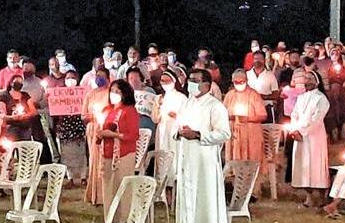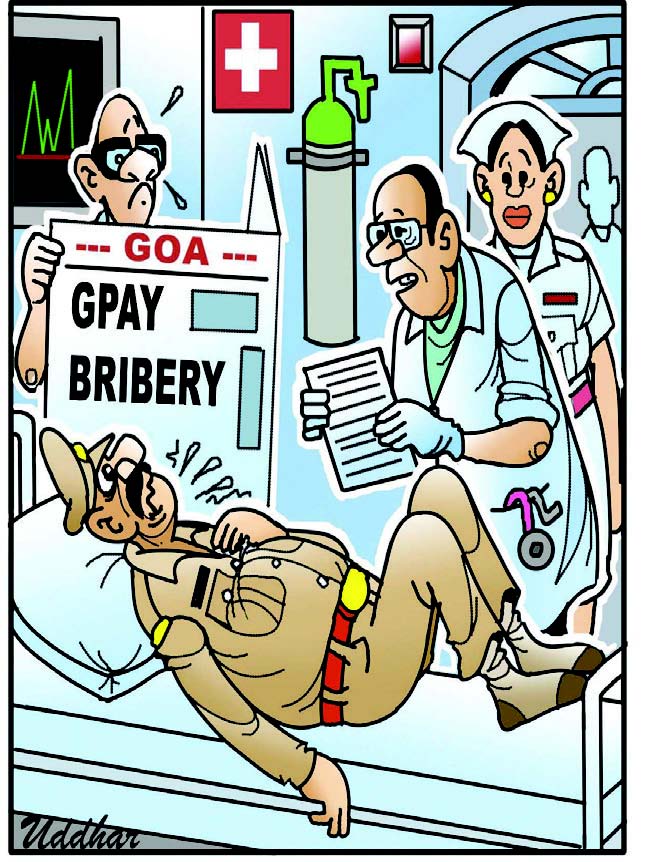
Doesn’t the news that a puja was conducted at the old Sancoale church frontispiece bring back memories? The choice of a religious space of a minoritised religion for the ritual. The justification that there was a Hindu temple there earlier. The selection of a ruined shrine, so that it can be argued that the place is not an active religious space at all. The focus on a precious monument, so that the message hits home to all and sundry, causes deep offence, and can become a powerful political issue.
The parish priest of Sancoale said, in his complaint to the police, that, on hearing of strange activities at the site on December 30, he arrived there to find some 25-odd people conducting the religious rituals of another religion while touching the church frontispiece. When he objected, stating that the group had trespassed into Church property, they argued that there existed a religious structure there prior to the Church, and hence they had a right to perform their religious ceremonies. They also stated that their goddess had appeared in their dreams and asked them to perform their rituals in the said property.
It hardly needs to be said that these are ridiculous explanations. As someone inquired on social media, would one be allowed to perform a non-Hindu ritual, like a Catholic mass or an Islamic namaaz, at a Hindu temple, by claiming a deity had requested this in a dream? Even if it is true that a Hindu religious structure existed on the site prior to the church, this is hardly a valid argument for performing Hindu religious rituals at the church. What about all the structures that existed on the sites where Hindu temples are today found, including those belonging to Buddhists, Jains, and especially tribal and indigenous worshippers? Would these worshippers be allowed to conduct their rituals inside the Hindu shrines today? The best example is the destroyed Babri Masjid itself; would people be allowed to perform namaaz in the new temple being built on the site, because a mosque had existed there earlier?
Why, forget about conducting a non-Hindu ritual in a Hindu shrine, Hindu worshippers are themselves often prevented from even entering Hindu shrines if they happen to belong to the wrong caste. An example is the high-profile visit of the President of India to the Jagganath temple at Puri in 2018, where Ram Nath Kovind and his wife – who were not trying to perform any new rituals, but only wanted to worship as per the usual Hindu worship practices – were momentarily blocked from entering, and even shoved aside, by priests. The behaviour was so clear and offensive that Rashtrapati Bhavan sent an official letter of complaint later to the local authorities. And this temple, please note, is also a protected public monument. But there is no report of either the archaeological authorities or the local ones taking any action, or even publicly condemning the behaviour of the priests.
In 2017, following a complaint about miscreants at Sancoale, Goa’s Directorate of Archaeology and Archives (DAA), which is entrusted with the protection of this monument, responded by saying that since it was a public monument, nobody could be stopped from visiting it. This of course sounds great, especially for the education of worthies like the Jagganath temple priests. But does it mean that visitors can perform religious rituals belonging to a different faith?
My own experience of the rules of the Archaeological Survey of India (ASI), which is supposed to protect the most important monuments in the country, is that, while visitors are encouraged, respect to customary religious practices is given primacy in the case of religious sites. I have not been allowed to even enter some Hindu temple monuments in India, despite having ASI permission for study and documentation, because the local priests refused admission; although the ASI says that the instructions of their on-site officers are final, this, in practice, means the instructions of the local priests. Thus, while the extent of access granted has varied from temple to temple, one message is clear everywhere, that respect must be shown to the religious sentiments of the priests and worshippers. It is difficult to even imagine anybody daring to perform rituals not acceptable to the former in these places.
In Goa, Catholic shrines have traditionally been more open and welcoming of all, compared to Hindu ones which, besides discriminating on the basis of caste, also bar women who are in their menses or divorced, and foreigners too. At Sancoale, this welcome was grossly abused. The action of performing a puja at the church frontispiece was clearly intended to offend and disturb Catholic worshippers, also to foment trouble between religious communities, and so create a political issue which has the potential – given the history of this country – to result in large-scale violence, and the destruction of a religious and historical monument. The modus operandi is already laid out – first the claim of divine apparitions and guidance, then the creation of a ‘disputed site’, then the push to settle it in the courts, which now have the Ayodhya precedent to guide them in favouring the take-over of the site by hate-spewing and history-falsifying groups claiming to represent the majority community.
And, despite a complaint by the parish priest of these offences and dangers, no action has been taken. The DAA is silent. Even an FIR is yet to be filed; the police say they are still investigating, though videos of the puja were uploaded on social media by the offenders themselves. Can it be clearer that these offenders, and their attempt to intimidate the minoritised Catholic community, enjoy State support? And why wouldn’t the State support them, when their puja conveniently distracts from the struggles for environmental justice across Goa today, including State violence against communities fighting for their future, and the growing unity of Goans against the destruction of their land? Yes, déjà vu, and a good diversion too.
(Amita Kanekar is an architectural historian and novelist)
